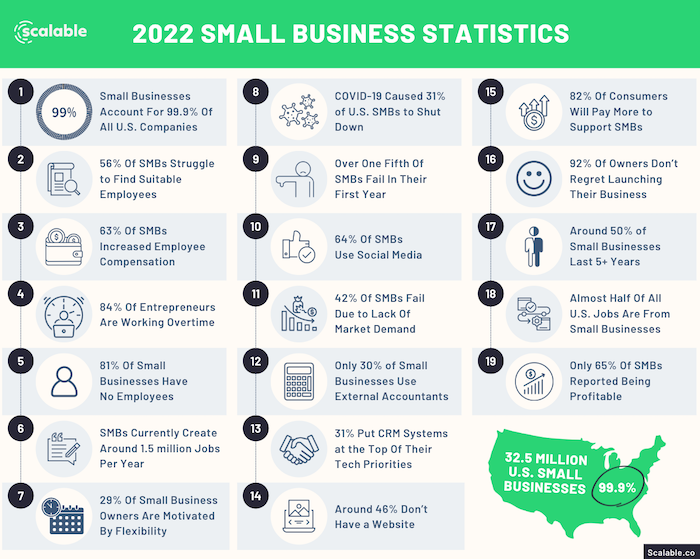

The US Small Business Administration defines a small business as a “firm with fewer than 500 employees.” If you’re a small business owner or budding entrepreneur, the sheer complexity of the current economic landscape may seem tricky to navigate. You’re probably wondering whether other companies face similar obstacles to those you’re experiencing – or how long you can expect to wait before you see growth. While every business is different, analyzing recent stats and trends can help guide your strategic decisions and boost your chances of making a sizable profit. With this in mind, here are some surprising 2022 small business statistics you should know.
1. Small Businesses Account For 99.9% Of All U.S. Companies
According to recent stats from the Small Business Administration, there are around 32.5 million small businesses in the US, amounting to 99.9% of all companies in the country. With so many small players out there, you’ll need to conduct comprehensive competitor research to stay ahead of the game.
2. 56% Of Small Businesses Struggle to Find Suitable Employees
With unemployment rates down and workers increasingly keen to find roles that cater to their personal tastes, 56% of small business owners find it “somewhat difficult” or “very difficult” to recruit the right employees. Many companies are investing more money and time into attracting top talent in the coming months.
3. 63% Of Small Business Owners Have Increased Employee Compensation
According to Guidant Financial, around 63% of small business owners have boosted their compensation rates to ensure they retain excellent employees and remain competitive in a tough economy. If you’re looking to combat the so-called “Great Resignation”, it’s worth considering whether you can afford to pay your employees more. Boosting salaries is likely to be cheaper than spending a heap of money on recruitment.
4. 84% Of Entrepreneurs Are Working Overtime
Around 84% of small business owners work more than 40 hours per week. If you’re looking to enjoy a manageable work-life balance and avoid burnout, you’ll need to put measures in place to reduce your workload. Such measures could include hiring extra staff members, outsourcing certain tasks, or planning your work week in advance.
5. 81% Of Small Businesses Have No Employees
A staggering 81% of small business owners do not employ people to help with everyday operations. If you’re going it alone, it’s worth considering whether you need to outsource certain jobs to lower your workload and reduce burnout so you’re able to focus on growth and scale.
6. Small Businesses Currently Create Around 1.5 million Jobs Per Year
On average, small businesses generate around 1.5 million new jobs every year. This represents a significant benefit for the economy and society at large. Promoting your job-generating potential could help you secure more funding from partners and improve your brand positioning.
7. Around 29% Of Small Business Owners Are Motivated By Flexibility
According to a large survey conducted by Guidant Financial, almost 30% of entrepreneurs have opened small businesses to become their own bosses. Free from the frustrations of micro-management or rigid working hours, many small business owners discover that self-employment unleashes their creative potential and improves their overall quality of life.
8. COVID-19 Caused 31% of U.S. Small Businesses to Shut Down
In 2020, the COVID-19 pandemic caused 31% of small businesses to shut down. While many businesses have bounced back, the economy is still very different to where it was before 2020, meaning many small businesses continue to face financial difficulties and tough decisions.
9. Over One Fifth Of SMBs Fail In Their First Year
According to the Bureau of Labor Statistics, 20.4% of small businesses fold in their first year. This number grows significantly in years 2-5.
10. 64% Of Small Businesses Use Social Media to Promote Their Goods and Services
Social media represents an invaluable marketing tool for almost two-thirds of small business owners. Channels such as Instagram and Facebook are great for targeting specific demographics and optimizing your advertising budget. Plus, they’re simple to begin using.
11. 42% Of Small Businesses Fail Due to Lack Of Market Demand
Around 42% of small businesses fail due to issues surrounding demand. If you’re operating in a struggling sector, you may need to expand into other markets to stay afloat, particularly if demand tends to be seasonal. Get creative, and don’t be afraid to take on unfamiliar niche markets.
12. Only 30% of Small Businesses Use External Accountants
A mere 30% of small business owners hire external accountants to help them analyze cashflows and make vital financial decisions. Dealing with your own business accounting could cause problems in the long term. Accountants can help to keep business owners out of legal trouble and ensure they’re making the most of their budgets.
13. 31% Put CRM Systems at the Top Of Their Tech Priorities
According to recent stats from Salesforce, 31% of small businesses place customer relationship management (CRM) systems as the top priority for their technology budget. The reasons behind this trend include the ability of CRM systems to generate sales reports, attract more leads, and provide better customer service.
14. Around 46% Of US Small Businesses Don’t Have a Website
Shockingly, almost half of small businesses in the US are yet to build a website. While this may not represent an issue for niche local businesses, most companies benefit from nurturing an online presence. Google represents the first port of call for many people looking for goods and services. By creating and optimizing your website, you’ll capture this significant pool of potential customers and drive growth.
15. 82% Of Consumers Will Pay More to Support Small Business
A whopping 82% of consumers are willing to spend more of their hard-earned cash on goods and services if it means they can support small businesses. There’s never been a better time to promote the home-grown aspect of your brand and emphasize the uniqueness of your goods and services.
16. 92% of Small Business Owners Don’t Regret Launching Their Business
We’ve got great news for entrepreneurs looking to take the plunge and start their own company – 92% of small business owners don’t regret launching their businesses. While most entrepreneurs experience hiccups at the start of their careers, the rewards you collect along the way will make it all worth it.
17. Around 50% of Small Businesses Last 5+ Years
About 50% of small businesses survive longer than five years. While this may sound scary, you can avoid failure by arming yourself with the knowledge and resources you require for growth. To find these resources, you’ll need to engage in plenty of planning. Key factors to consider include whether you have enough capital to launch, whether you have enough team members on board, the types of competitors you face and whether your model works.
18. Almost Half Of All U.S. Jobs Are From Small Businesses
According to the United States Small Business Economic Profile report, about 47% of jobs are at small businesses, accounting for over 61 million jobs.
19. Only 65% Of Small Businesses Reported Being Profitable
According to the Guidant Small Business Report, 65% reported being profitable, with 35% operating at a loss.
Summary
As you can see from these 2022 small business statistics, there’s a lot changing in the landscape. Our mission at Scalable is to create 10,000 “Level 7” entrepreneurs, and a big reason for that is because we know firsthand how much small businesses can positively impact the economy and people’s livelihood.


